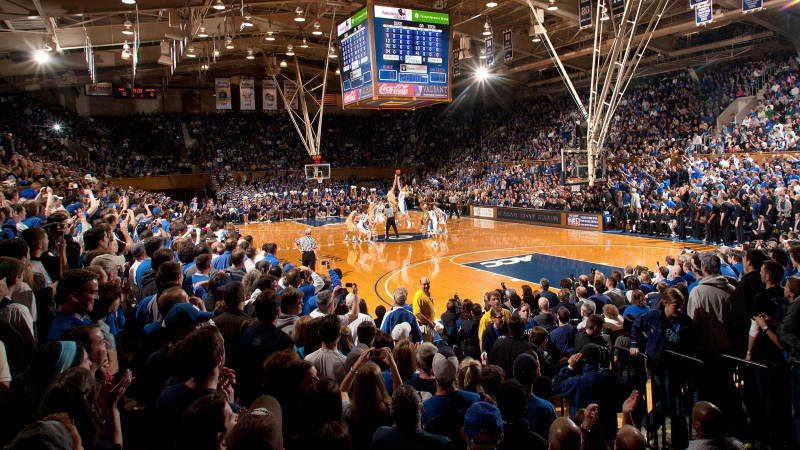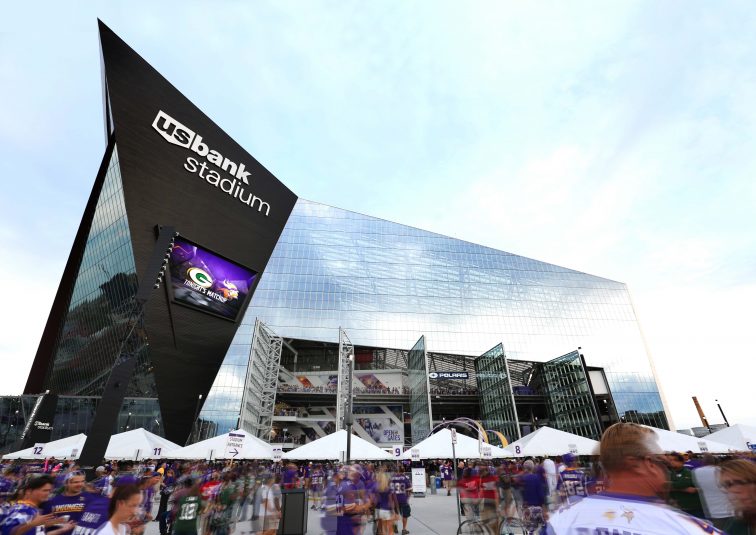Tech Focus: Acoustics
By Michael msilbergleid
Thursday, April 6, 2017 - 2:42 pm
Print This Story
| Subscribe
Story Highlights
By Dan Daley, Audio Editor, Sports Video Group
Part 1 — In-Venue Noise Remains an Issue
The challenge is still to balance volume and intelligibility
There have been a few occasions when venues have tried to use technological means to amp up the sound. These have tended to end badly. For instance, in 2015, the NFL’s Atlanta Falcons were fined $350,000 and loss of a draft pick when an investigation prompted the team’s owner to acknowledge that that fake crowd noise was played inside its former Georgia Dome home stadium. That same year, the Cleveland Browns were fined $250,000, and GM Ray Farmer was suspended four games for his violation of the league’s policy on electronic noise enhancement.

Acoustics were improved by consideration of sound during design of Duke University’s Cameron Indoor Stadium.
The issue still crops up; one A/V integrator reports that he has heard of at least one PA-system manufacturer that had approached a vendor about the sale of DSP that can digitally enhance crowd noise. (That may not necessarily be as nefarious as it sounds: the number of new loudspeaker-systems manufacturers and distributors in the U.S. market more than doubled in the last decade, and the number of regional and local sports venues that want to emulate major-league fan experiences — and where NFL and NBA noise ordinances are unenforceable even if they’re even known about — is nearly uncountable.)
Physics 101
Mostly, say A/V integrators and consultants specializing in sports-venue sound, the main challenge remains physics 101: trying to balance the demand for high SPL volumes with both speech intelligibility and full bandwidth for music reproduction.
“Basic acoustic principles still apply,” says Vance Breshears, a director at acoustical-consulting firm Idibri, whose portfolio includes AT&T Park, Chase Field, Fifth Third Bank Stadium, and the Circuit of the Americas F1 track. “It’s about shifting the balance between acoustical energy for the home-court advantage and intelligibility for the PA. And it’s a tough balancing act.”
He notes that sports venues are increasingly borrowing techniques from entertainment venues, which is not surprising given the degree to which music and other theatrical elements have become intertwined with sports events in recent years. These include a technique used often in performing-arts centers: more-reflective materials are located closer to seating areas, where the early reflections help add a sense of immediacy to the aural ambience around fans, and more-absorptive materials are in more-distant areas, such as rafters and fixed domes, where they can mitigate longer reverb times that can turn music and speech into mud.
Breshears points to new acoustical-treatment products that make it easier to tune venue acoustics spectrally, by truncating specific frequencies. That’s easier in the upper and upper-mid frequency ranges but becomes more challenging below 500 Hz, the direction music has been trending for some time.
“The thinking used to be that thicker treatment was what you needed to manage lower frequencies, but what we’ve come to realize is that you also need air behind that treatment to make it most effective,” he explains. This pursuit is also being helped by the greater use of predictive-analysis software, such as EASE, which can model the spatial and acoustical characteristics of various room designs — specifically, the noise-reduction coefficient (NRC), a representation of the amount of sound energy absorbed upon striking a particular surface — in a virtualized environment.
Can Systems Solve Acoustics?
As good as acoustical modeling and treatment have become, not every sports venue gets the benefit. “In the biggest of them, acoustical treatment often ends to get value-engineered out,” says Justo Gutierrez, director, A/V for sports and live events, Diversified Systems, an A/V integrator whose projects include Safeco Field and O.co Coliseum. Diplomatically opining that acoustical issues are often barely acknowledged in sports-venue construction, he adds that it’s more of a problem than it might seem, because it puts the onus for solving acoustical issues on sound-system design.
“Scoreboards and other very visible elements of the design tend to drive the costs, but ‘invisible’ aspects like acoustics tend to get ignored or minimized,” he explains. “The problem is, a sound system is only as good as the environment that you put it in.”
In fact, acoustical treatments can cost more when they have to be applied retroactively instead of being implemented as part of a construction or renovation project. That’s because they have to address architectural aspects put in place without consideration of their impact on sound propagation and because they often come after a new sound has been tuned to adapt to an acoustically challenging space and will have to be retuned after treatment is installed.
Gutierrez, who previously worked at consultancy WJHW and A/V integrator AVI/SPL’s sports division, says consultants are in the best position to advocate for acoustical treatments during the design phase and before construction begins. He cites WJHW’s work on Duke University’s Cameron Indoor Stadium — home to the “Cameron Crazies”, whose loud cheering has registered as high as 121.3 dB — as an example of an acoustical outcome that was improved by early collaboration with the architects on the project.
“One way or another,” he says, “there’s going to be a cost associated with not paying attention to acoustics.”
Part —Is ETFE a Miracle Material or Sonic Speed Bump?
Sports-venue sound design has a new element in the narrative
The story of sports-venue acoustics is a tale of unintended consequences. The rise of the massive domed stadium in the 1970s unleashed reverberation issues that made Lou Gehrig’s 1939 farewell speech at Yankee Stadium sound like a model of intelligibility and plague them to this day. The NBA’s embrace of hip-hop in the early 2000’s introduced the challenges of low-frequency energy at high SPLs into large, hard-surfaced arenas. Backlash against publicly funded stadiums used for all of eight games a year compelled municipalities to demand multifunctional applications from their new civic venues; that meant that music would have to cohabit with sports and trade shows, each with disparate audio requirements.
Though providing an outdoor feel and protection from the weather for U.S. Bank Stadium, the ETFE in the roof spurred noise complaints.
The latest wrinkle to disrupt the sector is ETFE, more formally known as ethylene tetrafluoroethylene, a co-polymer resin that is extruded into a thin, translucent film. For architectural-engineering firms like Thornton Tomasetti, which was the lead structural engineer on the Minnesota Vikings’ U.S. Bank Stadium and did structural renovations for the Miami Dolphins’ Hard Rock Stadium, ETFE is a wonder drug. As venues seek more natural light and better connectivity to the environment around them, ETFE offers structural strength but design flexibility.
“ETFE transforms enclosed facilities into light-filled, dynamic spaces,” the firm proclaims on its website. “Enclosed facilities have four-season functionality, which expands programmability and increases revenue for owners and operators. … [D]ark, confined atmospheres of conventionally roofed venues are no longer in step with patron expectations. At the 66,200-seat U.S. Bank Stadium, which hosts NFL football, MLS soccer, NCAA basketball and baseball, high school sports, motocross races, concerts, conventions and other events, the ETFE roof admits abundant natural light, creating an outdoor feel while protecting occupants from the elements.”
Side Effects
However, like many miracle cures, ETFE has its side effects. Brian Elwell, senior consultant at design consultancy Idibri, which integrated A/V for all the premium and team spaces —clubs, suites, locker rooms, meeting rooms — at U.S. Bank Stadium, says that, while ETFE’s transparency is welcome, its foil-like, semi-rigid nature tends to reflect high-frequencies while letting LFE pass through.
With a roof made of conventional materials, absorptive acoustical treatment could be added to the underside to help control some of the HF and mid-range reflectivity. But ETFE doesn’t offer enough mass to allow that to be applied. As a result, says Elwell, venues that contain ETFE design elements may experience elevated noise levels by comparison, unless the acoustics are addressed by other mitigating treatments.
From an architectural perspective, ETFE was the perfect solution for U.S. Bank Stadium: it let the venue address team owners’ desire for a stadium with an outdoor feel that also offered year-round, all-weather use but without the high cost of a retractable roof. The result, designed by architecture firm HKS, is a cover that is 60% ETFE, the largest of its kind in North America, spanning 240,000 sq. ft. The translucent roof and large wall panels also give fans a view of downtown Minneapolis while providing protection from the snow, rain, and cold.
However, noise complaints there began as soon as the first notes of concerts by country-rocker Luke Bryan and Metallica rang out last August. And reports of the venue’s inaugural NFL match, between the Vikings and the Green Bay Packers were characterized as “ear-splitting.” Not everyone saw this as a drawback, including Vikings coach Mike Zimmer, who recognized it as part of the home-field advantage. But, with preseason game measurements topping out at 114 dB, above the average human pain threshold of 100 dB, U.S. Bank Stadium could end up on OSHA’s watch list for employees.
According to Kevin Day, associate principal at WJHW, the consultancy that designed the bowl sound for U.S. Bank Stadium, some of the confusion surrounding ETFE’s properties was caused by its marketing materials, which portrayed it as acoustically friendly. However, he points out, the fine print in the material’s documentation notes that it was tested as a limp mass. Once ETFE is stretched out in its typical stadium application, it becomes resonant and reflective, with its specific frequency-response characteristics dependent on the degrees of tension and dimension each application calls for.
“Yes, it has better absorptive qualities than plate glass,” Day deadpans, “but we found that, under tension, it behaves a lot like other materials used [in stadium construction].”
At U.S. Bank Stadium, the architectural design called for the ETFE to be positioned opposite the side that was treated acoustically. That did result in the reflections’ being aimed at the visiting team’s side of the venue, underscoring its appeal for coach Zimmer.
Day says that wasn’t necessarily intentional. “They also had HVAC noise and a ceiling with a low R factor to deal with,” he explains. “So they went 50-50 on where the ETFE and the acoustical treatment were placed.”
He sees ETFE as one more evolutionary step in a process in which sports venues have to accommodate changing economic and political exigencies in their design. It succeeds Birdair, the material used to cover such venues as the Arthur Ashe Stadium at the USTA Billie Jean King National Tennis Center, succeeding the steel domes of the early domed-venue era. But ETFE will require ancillary design elements when it comes to sound: for example, even greater emphasis on loudspeaker directivity and precise coverage patterns and more interaction between outside-production users, such as concert touring, and the house sound systems.
“Everyone has to meet each other halfway now,” Day says. “We learned a few more things about ETFE in regard to room acoustics on [the U.S. Bank Stadium project] and expect to get even more data/experience from venues currently under construction.” (The Miami Dolphins’ Hard Rock Stadium will be the second major sports venue to use ETFE.)
As with all new materials and techniques in venue design and construction, time and experience will eventually deliver new solutions. But, says Elwell, “ETFE is here to stay” as an element of stadium design. “In terms of sound, we’re going to have to learn to work with it.”

